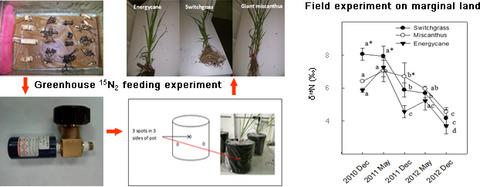当前位置:
X-MOL 学术
›
GCB Bioenergy
›
论文详情
Our official English website, www.x-mol.net, welcomes your
feedback! (Note: you will need to create a separate account there.)
Associative nitrogen fixation linked with three perennial bioenergy grasses in field and greenhouse experiments
Global Change Biology Bioenergy ( IF 5.9 ) Pub Date : 2020-10-19 , DOI: 10.1111/gcbb.12744 Jayani J. Wewalwela 1, 2 , Yuan Tian 3 , Janet R. Donaldson 4 , Brian S. Baldwin 5 , Jac J. Varco 5 , Brett Rushing 5 , Haoliang Lu 6 , Mark A. Williams 7
Global Change Biology Bioenergy ( IF 5.9 ) Pub Date : 2020-10-19 , DOI: 10.1111/gcbb.12744 Jayani J. Wewalwela 1, 2 , Yuan Tian 3 , Janet R. Donaldson 4 , Brian S. Baldwin 5 , Jac J. Varco 5 , Brett Rushing 5 , Haoliang Lu 6 , Mark A. Williams 7
Affiliation

|
Associative nitrogen (N2)‐fixation (ANF) by bacteria in the root‐zone of perennial bioenergy grasses has the potential to replace or supplement N fertilizer and support sustainable production of biomass, but its application in marginal ecosystems requires further evaluation. In this study, we first combined both greenhouse and field experiments, to explore the N2 fixation effects of three temperate feedstocks Miscanthus × giganteus (giant miscanthus, Freedom), Panicum virgatum (switchgrass, Alamo), and Saccharum sp. (energycane, Ho 02‐147). In field studies across three growing seasons, plant and soil pools of candidate feedstocks were partially composed of N derived from the atmosphere (Ndfa). Energycane, giant miscanthus, and switchgrass were estimated to derive >30%, %Ndfa. Greenhouse studies were also performed to trace isotopically labeled 15N2 into plant biomass and soil pools. Evidence for Ndfa was detected in all three feedstock grasses (using reference 15N of soil, chicory, and sorghum, δ15N~+7.0). Isotopically labeled 15N2 was traced into biomass (during grass elongation stage) and soil pools. Extrapolation of rates during the 24 hr labeling period to 50 days estimated 30%–55% of plant Ndfa, with the greatest Ndfa for energycane. The findings of the field natural abundance and greenhouse 15N2 feeding experiments provided complementary evidence that perennial bioenergy grasses have the potential to support relatively high rates of ANF, and accumulate diazotroph‐derived N into biomass when grown on non‐fertilized soil.
中文翻译:

在田间和温室实验中,联合固氮与三种多年生生物能源草有关
多年生生物能源草根区细菌的缔合氮(N 2)-固着(ANF)有可能替代或补充氮肥并支持生物量的可持续生产,但其在边缘生态系统中的应用需要进一步评估。在这项研究中,我们首先结合温室和田间实验,以探讨三种温带原料Miscanthus × giganteus(巨型猕猴,自由),Panicum virgatum(柳枝switch,阿拉莫)和蔗糖对N 2的固定作用。sp。(energycane,Ho 02-147)。在三个生长季节的田间研究中,候选原料的植物和土壤库部分由来自大气的氮组成(Ndfa)。据估计,藤茎,巨型猕猴和柳枝to可产生> 30%的Ndfa。还进行了温室研究,以将同位素标记的15 N 2追踪到植物生物量和土壤池中。在所有三个原料禾草检测证据NDFA(使用参考15土壤,菊苣,和高粱的N,δ 15 N〜+ 7.0)。同位素标记的15 N 2被追踪到生物量(草伸长期)和土壤池中。在24小时标签期到50天的时间外推率估计占植物Ndfa的30%至55%,其中能量藤的Ndfa最大。田间自然丰度和温室15 N 2饲喂实验的发现提供了补充证据,表明多年生生物能源草有潜力支持相对较高的ANF率,并在非肥料土壤上生长时将重氮营养型氮积累到生物量中。
更新日期:2020-11-17
中文翻译:

在田间和温室实验中,联合固氮与三种多年生生物能源草有关
多年生生物能源草根区细菌的缔合氮(N 2)-固着(ANF)有可能替代或补充氮肥并支持生物量的可持续生产,但其在边缘生态系统中的应用需要进一步评估。在这项研究中,我们首先结合温室和田间实验,以探讨三种温带原料Miscanthus × giganteus(巨型猕猴,自由),Panicum virgatum(柳枝switch,阿拉莫)和蔗糖对N 2的固定作用。sp。(energycane,Ho 02-147)。在三个生长季节的田间研究中,候选原料的植物和土壤库部分由来自大气的氮组成(Ndfa)。据估计,藤茎,巨型猕猴和柳枝to可产生> 30%的Ndfa。还进行了温室研究,以将同位素标记的15 N 2追踪到植物生物量和土壤池中。在所有三个原料禾草检测证据NDFA(使用参考15土壤,菊苣,和高粱的N,δ 15 N〜+ 7.0)。同位素标记的15 N 2被追踪到生物量(草伸长期)和土壤池中。在24小时标签期到50天的时间外推率估计占植物Ndfa的30%至55%,其中能量藤的Ndfa最大。田间自然丰度和温室15 N 2饲喂实验的发现提供了补充证据,表明多年生生物能源草有潜力支持相对较高的ANF率,并在非肥料土壤上生长时将重氮营养型氮积累到生物量中。











































 京公网安备 11010802027423号
京公网安备 11010802027423号